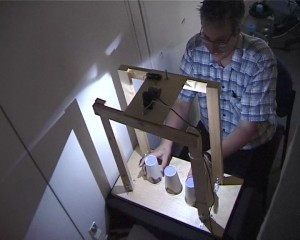Piloting the Cup Game
The cup game performance was designed in an iterative process by running it on people in the Mixed Reality Lab.
This process was run for 10 people in total, until the performance and the technology had not had any major changes for the last 5 iterations. This also allowed me to get better at tricking people, and to have the script memorised well. I learnt several lessons from the pilot which are summarised below.
People Trust Computers
Initially, I let the computer guess which cup the bead was under and then let the person choose. However, it appeared that even if they thought they knew different, pretty much everyone would trust the computer’s guess more than their own.
The Computer Can’t Screw Up
If you have hidden the existence of a computer, it really has to work first time, and not crash ever. The first test I ran, had a weird bug that only occurred when the computer was left running for 5 minutes or so - ie. when I was briefing someone on the trick. Fixing it kind of destroyed the illusion. Ooops.
You Can’t Screw Up
In some of the earlier tests, I screwed up switching the bead, or shuffled the cups to end in the wrong place. This required some quick thinking to act as if that was what I meant to do, in order to get out of it. In the end, I altered the script so that I had pre-planned get outs for each possible error, after which I somehow managed to perform it fine every time, so didn’t have to use them!
They Can’t Screw Up
This is really me screwing up in giving instructions, but if the audience member doesn’t do what you tell them to, it can really mess up a trick. I altered the game to add a pause before a crucial reveal in one of the tricks, so that in the case of the person doing something wrong, I could reset the trick and get them to do it again.
Related themes:
Magic,
Performances,
